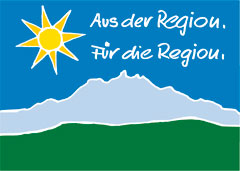10 years of «From the region. For the region.»: Goodness grows close to home
A label that became a success story. Ten years ago, «From the region. For the region.» was launched in Central Switzerland and now ensures that Migros is number one for local and regional products throughout the country. The concept has been part of the national Migros strategy since 2009.
It looks as though a green shag-pile carpet has been rolled out: At the Schmied market garden in Ried bei Kerzers, in the Canton of Fribourg, lamb’s lettuce is growing, the plants densely packed together. Every year between November and April, Dominic and Olivier Schmied, the two proprietors, plant four million seedlings – and harvest a total of 50 tonnes of lettuce – for Migros, for the «From the region. For the region.» label.
Production for Migros began in 2005, when the brothers took over operations from their father. Since then, «growth has been steady», says Olivier Schmied. «With its range of regional products, Migros promotes local agriculture.» The number of staff has doubled from six to twelve, an apprentice joined the team for the first time two years ago and an additional greenhouse was built next to the original one in 2009. The market garden measures 18 hectares, including the greenhouses where lamb’s lettuce is grown in the winter and tomatoes and cucumber in the summer. Outdoors, the land is planted with butterhead, iceberg, and loose-leaf lettuce. Then there are vegetables such as leeks, Chinese cabbage and chicory.
10 years of «From the region. For the region»

«From the region. For the region.» – the label that stands for products cultivated and produced where the consumers live – celebrated its tenth anniversary in 2009. The label originated from Central Switzerland at a time when food scandals such as BSE were hitting the headlines and the whole world was talking about globalisation and international purchasing. The Migros Cooperative Lucerne decided to create a counter-trend – regionalisation. It launched a label so that people would know which products were local. «The label represents freshness, short transport routes and food safety», says Michel Reber, Head of Marketing Communication at the Migros Cooperative Lucerne, who has accompanied the label from the start. «The farmers and producers who supply us all have to comply with the minimum standards of the IP-Suisse eco-label.» And by mid-2010 at the latest, the fruit, vegetable and flower growers will have to have SwissGAP certification too. SwissGAP stands for good agricultural practice.
Working hand-in-hand
«As well as representing ecology and food safety, the label demonstrates its long-standing commitment to working with producers from the region», Reber says. «In some cases, we’ve been working with different generations of the same families for 40 years. At the end of each year, we get together and determine the quantities to be supplied for the following year. People doing business face-to-face.»
Growing success
The Migros Cooperative Lucerne’s figures for the regional label are impressive: in 2009, it accounted for 13 per cent or around CHF 110 million of food sales. As a result, the Cooperatives in Basel, Valais, Eastern Switzerland, Aare, Vaud and Zurich expanded their ranges to include products from the region. And since the label’s tenth anniversary in 2009, it has been part of the national Migros strategy. Products from the region are now available at all the Cooperatives.
Sustainable production
At the Schmied market garden, cultivating the crops for the label keeps everyone busy. Everything is harvested by hand – and employees have to kneel down to reach the lamb’s lettuce. Just watching them makes your back and knees ache! According to Dominic Schmied, «It looks more tiring than it is. The work trousers are well-padded at the knee and after a few hours, you get used to the position».
The working day starts at 6:30 am, both in summer and winter. In summer, the morning is devoted to harvesting, while the afternoon is reserved for crop tending and planting. This is also done by hand. In winter, root vegetables are cleaned in the morning and lamb’s lettuce is cut, weighed, washed, packed and prepared for shipping in the afternoon. Although the large greenhouses make quite an industrial impression at first glance, only a few tools are used to make work easier: a mini vegetable washer, a machine to break up the soil and prepare it for the next crop, a sprinkler for watering and a planting machine for the lamb’s lettuce. Rattling and clattering, it plants 10,000 plantlets an hour in perfectly straight lines in the dark soil.
Lamb’s lettuce for the whole winter. But don’t the Schmieds get fed up with it? «Oh no, it’s still our favourite lettuce», they both say in unison. And Olivier Schmied adds: «I’m sure that the many vitamins in it keep me healthy».